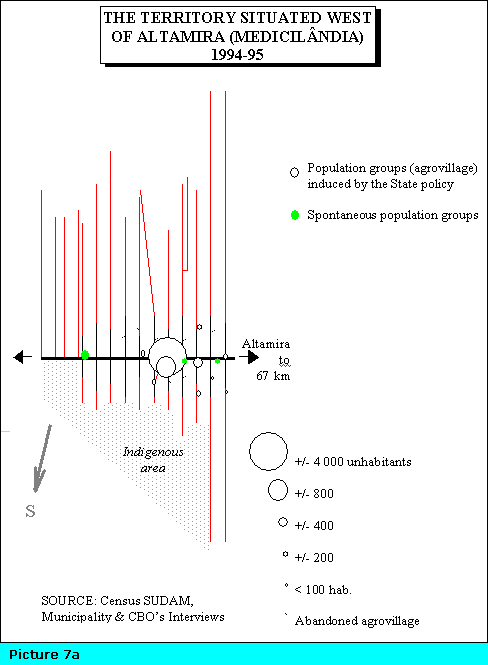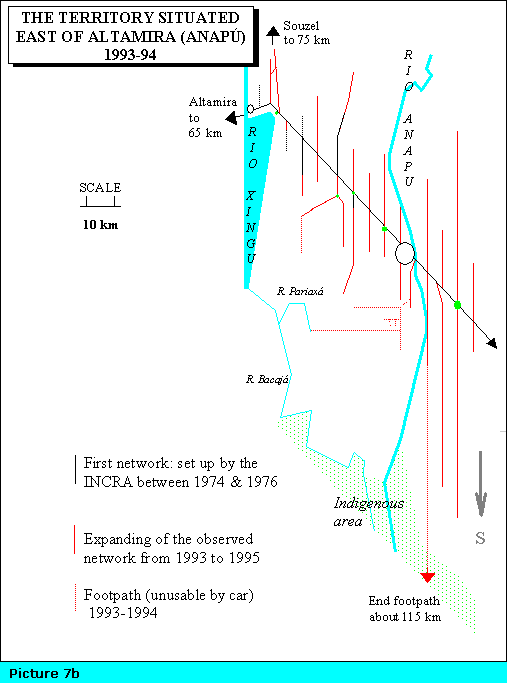The schematic views of the sub-regional territories illustrate the thesis and give a detailed description of the colonized areas and their management by the local actors. They also point out the human and historical differences between the east and the west of Altamira’s territory.
In the east and in the west as well, the linear colonization process and the exploitation system have never been questioned. The populations have settled along a road, whether the State intervened or not. Nowadays, the preservation and management of new installations at the frontier of the rainforest is difficult. The forestry enterprises in charge of the territorial management only open up road tracks. The planning network is expanding, confronting new municipalities to the decisive urban role of the populations that have settled in groups at the points of intersection of commercial trajectories (picture 7). The linear space developing structure hinders the setting up of the connections required for a good transport of products and people.


The emergence of a priviledged class of tradesmen
Production relies on individual strategies of profit-making and on strategies that have led to the establishment of a priviledged class of tradesmen whose authority of which is now questioned. The analysis of the tradesmen activities and of the marketing networks testifies to an elaboration of a network of intermediaries at the regional level. Yet, the trajectories of the intermediaries underline the differences between the commercial elites of the east and the west of Altamira.
In the west, the initial conditions of the colonization process have enabled small settlers to be more productive, raising continual crops such as cocoa, pepper and coffee. They have subsequently been able to develop their commercial activities. On the contrary, in the east, the settlers (mainly rice cultivators) have tried to set up commercial activities with the operational objective of increasing their production. Such an upstream strategy as opposed to the previous one, most often only works for individuals who can invest capital in cattle breeding and transport activities. In the east of the area, the unsettled pattern of retailers reflects the lack of elaboration of a planning scheme of production.
In the west, the economic crisis of 1987, with a fall in the cocoa prices and deterioration of pepper plantations has checked the production and even stopped the rise of farmers which were not involved in trade activities. It has even started to affect their working capital whereas the local tradesmen and producers have subsequently improved their standard of living.
As a consequence, the producers came into conflict with the tradesmen and they wanted to get rid of intermediaries (atravessadores). In actual practice, they have tried to set up new strategies, establishing a network of associations.
The same conflict has happened in the east, but is the result of different economic problems. It has been a long time since the main trade product, rice, is not sold anymore in its untreated form. So, it was replaced by cattle trade because of the lack of husking machines. Such an evolutionary process has set the small farmers apart since they are compelled to rely on many intermediaries such as tradesmen, retailers, transporters, and cattle breeders (fazendeiros).
Small organizations of producers progressively gain in power because they elaborate and set up collective development strategies. As a result of a development of these strategies, an innovative agricultural development process is changing the structuration of frontier areas, and particularly as regards the control of the colonization of Altamira, which has always favored the relationships between State and people.
The emergence of the power of collective small organizations counteracts the evolutionary development process
From the comparative study of the two sub-regions, it follows then that the new networks derived from these collective strategies deal more specifically with social or economic issues. This result should be underlined.
The west, Medicilandia, has been granted State credits in order to develop buoyant products (cocoa, sugarcane, pepper). The allocation of credit to the production has given birth to a middle class of agricultural producers and retailers and has also led to the development of urban areas. This production policy has favored local investments. The crop-raising of food products has given acute awareness, that the actors’ strategies could promote socio economic interests. In 1987, the economic crisis and the fall in the prices the cocoa have been the starting point of establishing new economic collective networks in the sub-region (the social projects were traditionally in charge of women). Small organizations of producers have been born thanks to a few leaders supported by their political and family network. The economic community project aims at actualizing the work of individuals involved in the trade and transforming of products. Producers do not rely on the commercial semi-extractive systems anymore.
In the east (Anapъ), the State has planned a landownership program with the help of private investments from the big owners who were granted land in return. The lack of a production scheme investing in buoyant products has stopped the process of land exploitation and has led to the settlement of a small spontaneous generation of pioneers because of the development program for unexploited areas. As a consequence a newly born class of producers (rice, cassava) the interests of whom big cattle breeders’. The problem of land appropriation and management (involving main issues such as the problem of isolation, a better access to services, land jurisdiction) has led to the forming of communities of producers.
Yet, the combination of social and economic issues is obviously part of the actors’ work. The progressist Catholic Church regulates individual clashes of interests. In bringing out its reflection upon collective interests, it leads to the forming of new associations. The Church interferes with the work of the local actors in a will to stand up for the project of a fair rural society, which may not be the producers’ first operational objective.
In the west (Medicilandia) the social project initiated by the Church, seems to have less importance. Yet, the community leaders, who are often militants of the PT, the Labour Party and who have a religious instruction in educational, political and unionist matters, say they are at the root of this project.
In the east (Anapъ) the producers have always been under Church supervision, which has enabled them to set up their own community network. But because of their slow economic process, the Church finds profitable ground to build its own social project, which depends its ability to develop economic projects, too.
Unfortunately, the relationships are rather strained amidst the great number of local actors on grounds of a strong opposition between the varied religious, political and economic groups. The fact that the religious communities (catholic or otherwise) act as a substitute for the Federal State leads to a disunity that hinders the territorial management. The combination of social and economic projects is an obvious necessity to agricultural producers. They need to rely on the combination of social and economic projects in order to set up their activities. But the actors’ responsibilities and abilities must be defined. The local authorities will have to accept further responsibilities. Either new future or the new independence of the municipalities enables the inhabitants to have more financial means and a better access to public services. It is also a first step towards the legal control of a territory within which the actors’ projects would officially be taken into account by the local authorities.
Medicilвndia, a municipality build in 1988, commits itself to the grouping of people in order to develop the relationships between local associations, development organizations and the elected representatives. The municipality can be described as an innovative field of social and economic improvements to the territorial management policy. But the elaboration of a common project plan remains an issue despite the fact that setting up collective and economic measures would seriously improve the standard of living of the population. The local administration confines itself to the traditional clientиle networks, being held in check when involved in the development and management of an uncontrolled and inefficient structure. This description reveals its weakness and lack of efficiency as regards to its responsibility of accounting for common interests.
The young collective structures (municipalities and associations) cannot operate a significant turn in the former evolutionary process because they are insufficiently developed. They highlight the actors’ behaviors, ambitions and organizational means at the micro local level.
|






